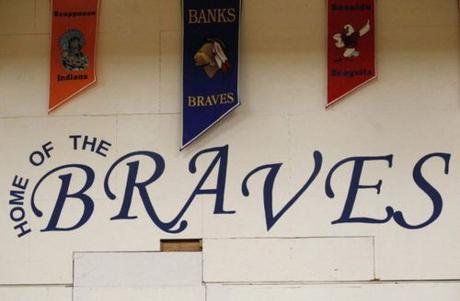
Oregon Live:Fourteen Oregon public schools that have fought to maintain their Native American-themed mascots in the face of state changes must pick new names by 2017, the Oregon Board of Education ruled this week.
State board members voted unanimously against an amendment that would have allowed schools to continue to call their athletic teams and other student organizations nicknames such as the Warriors, Braves, Indians and Chieftains.
“It’s a great victory,” said Sam Sachs, one of the activists who has fought to ban the names. “They stood their ground and said we’re not going to do it.” Native Americans have been asking state leaders to ban tribal-themed mascots since 2006.
Schools in Banks, Molalla and Roseburg still used Native American mascots. Seven Oregon schools called themselves the warriors. (Another, Aloha High School, earned a reprieve after proving its warrior mascot was Hawaiian, not Native American).
The state board studied the issue for years before agreeing, in 2012, to do so. The board ordered all schools with Native Americans mascots to choose new ones. Those who didn’t would lose state funding.
Republican legislators fought back. State Sen. Jeff Kruse, R-Roseburg, and Rep. Sherrie Sprenger, R-Scio, proposed bills that would allow some schools to keep their name. Governor John Kitzhaber vetoed a 2013 proposed bill but a year later agreed to allow schools that have the OK of an Oregon tribe to use a mascot with tribal significance.
The 2014 bill also directed the state board to come up with the rules for the agreement process. State officials created work groups to develop the rules and propose an amendment to existing standards that would allow some tribal mascots. Workgroup members spoke with members of nine federally recognized tribes. Some, such as the Siletz, did want to allow a local high school to use a tribal mascot. The workgroup considered whether to allow schools to ask permission from multiple tribes. They debated time frames for receiving approval.
Board members reviewed studies that said Native mascots promote discrimination, pupil harassment and stereotyping. They studied dropout rates and discipline data. Both painted bleak pictures: Last year, 3,130 Native American students enrolled in Oregon high schools. About 200 of those attended schools with Native American mascots. They comprise about 2 percent of enrollment but represent 4 percent of dropouts. They also are disproportionately suspended.
Finally, education board members agreed to vote on an amendment allowing some schools to keep their names. They rejected it, essentially reaffirming the initial 2012 decision to ban Native American mascots.
“For (the board), this really is a civil rights issue,” said Crystal Greene, a spokeswoman for the Department of Education. “It’s an equity issue. They felt like the action that had been taken in 2012 was an important one, and that this was in the best interest of kids.”
In February, the Banks School District asked more than 1,000 community members who they felt about changing the school mascot. Nearly 95 percent voted to retain “the Braves.” At least one school has changed its mascot during the back and forth. Last year, The Dalles High School dropped its mascot, the Eagle Indian. They played this year as the Riverhawks.
And this month in Lebanon, crews began working to sand down their gym floor to remove a logo of a Native American. A Native American “warrior” still appears on the school’s website and in its hallways.
So with this “civil rights” and “equity” issue now resolved, I look forward to seeing a positive reduction in the disproportionate number of Native America students who drop out and are suspended.
DCG

